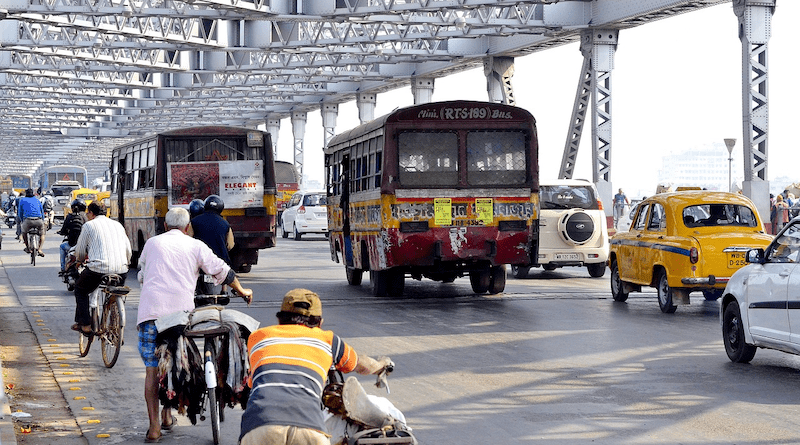Vibrant Gujarat Vs Bengal Global Business Summit: Why Bengal Failed To Lure lnvestments – Analysis
Once the epicentre for industry in India, West Bengal has been fading in the industrial map of the country. Seven decades ago, at the time of Independence in 1947, it accounted for 30 percent of country’s industrial output. Now, it has dipped to just 3 percent, according to Union Home Minister Amit Saha.
MNCs are crowding for investment in Gujarat, leaving West Bengal hungry for investment. Political belligerence downplayed the merit of West Bengal, even though it edges Gujarat geopolitically. Gujarat is more investment risky, being near to Pakistan and engulfed by 52 percent of the land as desert, in contrast to West Bengal being the gateway for South East Asia.
Vying a challenge to retrieve industrial development, the present government of West Bengal, TMC, has organiseed the Bengal Global Business Summit (BGBS) every year since 2015. The main objective of the summit is to attract investment in the state and reinvigorate the industrial buoyancy and create more employment .
But the success belied reality. Investors are reluctant to invest in West Bengal. They crowded in the summit, but refrained from investing. During 2015 to 2019, a total of Rs12,32,856 crores worth of investment proposals were signed in the summit. But only 3 percent or Rs37,504 crore was invested in the State, according to reports sent by State to Centre.
The slow pace of the success of the summit is due to lack of confidence and trust of the investors. The great economic reforms in 1991 could not nudge West Bengal. Focus continued on rural development, leaving industrial development on the back burner.
Hopes resurfaced for industrial development with the Communist government defeated in 2011 and replaced by TMC. But, soon hopes nosedived with TMC’s political overpower and leader Mamata’s image of anti-industrialism, stemmed from anti- Tata missile for setting up Nano car project in the state.
Unemployment heightened and the State came under the grip of social problems. Unemployment escalated political corruption and antagonised investors with rising red tape and Tola Baji (a forceful extraction of commission from small businessmen), instead of invoking ease of doing business and providing incentives for investment.
During 2016 to 2021, a total of 21,521 factories were shut down, according to the Department of Environment of West Bengal. In 2023, Care Rating survey dragged West Bengal down to 24th in the economic parlance.
In contrast, the Vibrant Gujarat summit became the boon to industrial investment in Gujarat. Now, Vibrant Gujarat is described as institution and not an annual event by Prime Minister Narendra Modi.
Vibrant Gujarat Summit leapfrogged Gujarat to the 3rd biggest receiver of foreign direct investment during October 2019 to December 2022. In contrast, West Bengal trailed behind at 10th rank. In industrial investment intensions (Industrial Enterprise Memorandum), Gujarat emerged as the 2nd highest potential destination for investment, as compared to West Bengal flailing at the bottom of the list.
Big houses and MNCs are rushing for investment in Gujarat. Investment proposals by Air Bus and Micron Technology for semiconductor manufacturing are the cases in point.
There are three trajectories of industrial development in West Bengal. First, since the Communist government came in power in 1977 and ruled for 34 years, focus was made on the rural sector. It developed the farm sector, but undermined the growth of industry. Resultantly, though West Bengal hogged the limelight for agro development, industrial development was at a nadir. These translates the economy in an unbalanced template, causing a disincentive for investors.
Second, industrial development in West Bengal can be viewed from the perspective of industrial development in developing nations, like in East Asia and South East Asia. When Communist China went for an open door policy, opening the economy to foreign investors and private sectors, posing a big challenge to South East Asian countries (mainly ASEAN nations) for global factory for the West, West Bengal reeled under the agro-economy, negating the global changes in technology upgradation and the global integration for manufacturing.
The third perspective arises with West Bengal’s volta face to 1991 reforms in India. When most of the state government initiated new industrial policies in the wake of reforms, keeping pace with Central Government new industrial era, West Bengal posed a silent observer of the reforms. This led an intense competition among the states for investment.
Nevertheless, West Bengal has special advantages to edge other states . One, it is bestowed with ample natural resources under the soil of Sonar Bangla (fertile land) , and second its geographical location in the east, which harbours for border trade with four nations and North East. Polarizing on these two strong parameters, which no other state embraces, West Bengal can usher a strong turf for border trade. It can be a pivot to India-ASEAN connectivity – the paradigm shift of Modi’s dynamism to rein in Asia under Act East policy.
Will Bengal resurrect at pre-1977 era levels for a new face of industrial development and decimate the unemployment problem, which has become a striking hinderance to the growth of the State? BGBS alone cannot fructify the industrial investment, unless ruling government showcases the State as industrial friendly State.
Can 7th BGBS, scheduled in November 2023, generate a desire for investment in West Bengal?

